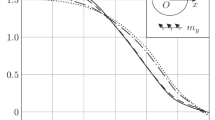We proposed a new theory of bending of axisymmetrically loaded plates in the form of thick rings or disks for the case where their deflections are not large and the stressed state is not described by the Kirchhoff–Love or Timoshenko hypotheses. For bending of this kind, we use two harmonic functions that describe the axisymmetric stressed state. After integration over the thickness of the plate, the momentsand transverse forces are expressed via two functions. The relationships of the theory of elasticity are exactly satisfied and a closed system of equations for the introduced functions is constructed without using any hypotheses about the geometric nature of deformation of the plate. A method for the solution of these equations is developed. We also present the solution of various problems of bending of the plates with holes.
Similar content being viewed by others
References
A. E. H. Love, A Treatise on the Mathematical Theory of Elasticity, 2nd edn., Cambridge Univ. Press, Cambridge (1906).
S. P. Timoshenko and J. N. Goodier, Theory of Elasticity, 3rd edn., McGraw-Hill, New York (1970).
A. S. Kosmodamianskii and V. A. Shaldyrvan, Thick Multiply Connected Plates [in Russian], Naukova Dumka, Kiev (1978).
L. H. Donnell, Beams, Plates, and Shells, McGraw-Hill, New York (1976).
S. Lukasiewicz, Local Loads in Plates and Shells. Monographs and Textbooks on Mechanics of Solids and Fluids, Sijthoff & Noordhoff, Alphen aan den Rijn (1979).
A. K. Noor, “Bibliography of monographs and surveys on shells,” Appl. Mech. Rev.,43, No. 9, 223–234 (1990).
H. Kobayashi, “A survey of books and monographs on plates,” Mem. Fac. Eng.,38, 73–98 (1997).
A. Lebée and K. A. Sab, “Bending gradient model for thick plates. Part I: Theory,” Int. J. Solids Struct.,48, No. 20, 2878–2888 (2010).
V. P. Revenko, “Three-dimensional problem of the theory of elasticity for orthotropic cantilevers and plates subjected to bending by transverse forces,” Fiz.-Khim. Mekh. Mater.,40, No. 2, 53–58 (2004); English translation:Mater. Sci.,40, No. 2, 215–222 (2004).
V. P. Revenko, “Reduction of a three-dimensional problem of the theory of bending of thick plates to the solution of two twodimensional problems,” Fiz.-Khim. Mekh. Mater.,51, No. 6, 34–39 (2015); English translation:Mater. Sci.,51, No. 6, 785–792 (2016).
V. P. Revenko, “Solving the three-dimensional equations of the linear theory of elasticity,” Int. Appl. Mech.,45, No. 7, 730–741 (2009).
Author information
Authors and Affiliations
Corresponding author
Additional information
Translated from Fizyko-Khimichna Mekhanika Materialiv, Vol. 55, No. 4, pp. 22–26, July–August, 2019.
Rights and permissions
About this article
Cite this article
Revenko, V.P. Bending of Axisymmetrically Loaded Thick Plates. Mater Sci 55, 477–483 (2020). https://doi.org/10.1007/s11003-020-00328-x
Received:
Published:
Issue Date:
DOI: https://doi.org/10.1007/s11003-020-00328-x



